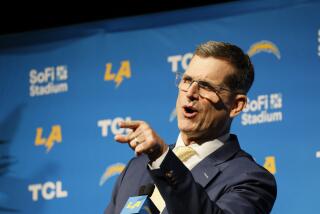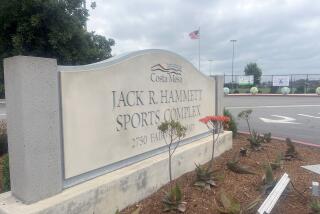New Chargers stadium design features a retractable roof and a sky garden
The Chargers released a conceptual plan Thursday for a 61,500-seat stadium with a retractable roof, an adjoining convention center featuring a rooftop “sky garden,” and a new 2-acre park.
Project architect David Manica stressed that “we have not dropped a spaceship” into what he said is an admittedly tight downtown site,
“We want it to be soft, friendly, of San Diego,” he said. “We want it to feel like a building that has been there for a long time, like a natural evolution of the downtown architecture.”
Manica said he drew his inspiration from San Diego’s mild climate, rugged coastline and sailing culture.
The design for the $1.8 billion project will be shared in meetings Friday with local officials, including San Diego Mayor Kevin Faulconer, and the public on Saturday, when the team launches a petition drive for the Nov. 8 election.
The initiative, which does not cover the design specifically, asks voters to raise the tax on hotel stays from 12.5 percent to 16.5 percent so that a city-controlled entity could sell bonds to finance much of the project cost. The team has said it would provide $650 million, with $300 million coming from the NFL and $350 million from the team, stadium-only sponsorship deals and advance payments from fans.
Team consultant Fred Maas said if the voters approve the project, the actual design will be the responsibility of an oversight agency set up by the city with team representatives and may differ from Manica’s concepts.
“These are merely conceptual,” he emphasized. “An enormous amount of work and dollars have gone into this, and everybody weighed in on the best compromise for the stadium and integrated convention center.” Maas said the Chargers have spent “seven figures” — more than $1 million — on design.
Manica said a key challenge was the 15-acre site — immediately east of Petco Park encompassing the Tailgate Park parking lot and the MTS bus yard, bounded by 12th and Imperial avenues and 16th and K streets.
“The truth is this site is not particularly spacious, even for a stadium on its own,” he said. “I would say it is barely enough — we don’t have an excess of elbow room on the site. It’s challenging to put two big buildings on what would be considered a small piece of land in the eastern area of (downtown) San Diego.”
See more of our top stories on Facebook >>
While the stadium itself would be among the smallest in the NFL, the design allows it be expanded to 72,000 seats, capable of accommodating a Super Bowl.
After considering various approaches, the Chargers design team decided to place the stadium at ground level rather than above a convention exhibit hall — an option that would have increased the height of the project another 60 to 75 feet to as much as 275 feet above the street.
Not only would that have affected the surrounding East Village neighborhood but there would have been limited opportunity for shops and restaurants at ground level, Manica said.
“That was one of the key charges for me,” he said. “We were told activating the street edges on all four sides of the building was very, very important.”
By design, the hybrid project could maximize the amount of space that could be devoted to conventions and local trade shows, as well as special events and concerts.
In keeping with what meeting planners say are growing space demands for exhibitors, the Chargers are proposing a total of 260,000 square feet of exhibit space, of which 100,000 square feet would be on the stadium floor adjoining the proposed convention center. That’s considerably more exhibit space than a previous city plan to enlarge the center on the waterfront.
The existing center’s exhibit floor spans more than 525,000 square feet.
A retractable roof made of an “architectural fabric membrane,” similar to what has been used at other stadiums, would protect the field during rain and convention events. A permanent roof would largely cover the stadium’s seating bowl.
The new convention facility also would include a 65,000-square-foot ballroom and 80,000 square feet of meeting rooms, plus a 150,000-square-foot rooftop “sky garden” that would feature cabana-style meeting rooms. Meetings, weddings and other events could take place in those spaces. The garden would link directly to the stadium’s concourse level through a large see-through opening that could be closed off to accommodate temporary seating for Super Bowl games.
“It provides an incredible panoramic views of San Diego, Coronado and the Coronado Bridge and creates a one-of-a-kind experience for stadium spectators,” Manica said. “No other stadium has a roof garden at the upper concourse level.”
Get the latest in sports with our free newsletter >>
San Diego tourism leaders and hoteliers have pressed for years for a contiguous expansion of the city’s bayfront San Diego Convention Center, arguing that meeting planners and conventioneers overwhelmingly favor such an arrangement as opposed to a separate facility blocks away.
Plans for a waterfront expansion, though, have been on hold since a court ruled that a hotelier-approved room tax increase to finance the project is unconstitutional. That plan called for more than 220,000 square feet of exhibit hall space, 101,500 square feet of meeting rooms and nearly 80,000 square feet of ballroom space.
But Maas, the Chargers’ stadium adviser, said the new stadium and convention center annex offer other features a contiguous expansion on the waterfront would not.
“This facility allows you to attract the Final Four, world wrestling, soccer and gives you the flexibility for Comic-Con who may decide they want U2 or the Rolling Stones,” Maas said. “There are a number of expanded convention facilities elsewhere that are disconnected, and the one difference is they don’t have our weather.”
However, hosting conventions and other special events means the field would have to consist of artificial turf rather than natural grass, Maas said.
Maas largely dismissed concerns raised previously by convention officials that it would be difficult to book large meetings years in advance, given the uncertainty of the NFL schedule of 10 to 12 home games a year.
“It will require everyone working together, there is some flexibility in the NFL season,” Maas said. “We have the advantage of working those issues out in advance.”
Among the challenges in siting the project is deciding how to handle the historic Wonder Bread Building on 14th Street. Manica’s design shows it relocated or replicated on the east side of the stadium on 16th street. Also contemplated as a part of the project is a museum, perhaps devoted to Comic-Con International, on the north side of stadium on K Street.
Another challenge Manica faced was dealing with an earthquake fault running along the western edge of the project site, which is southeast of the Central Library.
The convention building had to be moved eastward, away from the fault line, but that made it possible to create a “wonderful street-level park and garden” of about 100,000 square feet or a little over 2 acres, Manica said.
“It really turned it into one of the greatest assets of the project — a view corridor to the library — and a garden,” he said.
The replacements for 1,100 parking spaces at Tailgate Park, plus about 200 spaces, would be built in one underground level beneath the stadium and convention building.
In a nod to San Diego’s nautical history, Manica said he designed some of the building to “lean forward” — an allusion to the way sailboats heel over in the wind. He also incorporated some structural elements that recall Southern California’s “rugged” coastline.
Some East Village residents and business leaders have voiced concerns that the stadium would represent a very large structure out of scale with its surroundings.
“It confirms to us that it goes against everything that we believe should go there,” said Pete Garcia, a member of the East Village People group working on an alternate vision for the property as a innovation-economy jobs center. He called it too tall and monolithic and not “porous” or connecting to surrounding blocks.
Showley and Weisberg write for the San Diego Union-Tribune.
MORE FROM SPORTS
Chargers apply to trademark Los Angeles names
Appeals court upholds estimated $1-billion NFL concussion settlement
Molding an efficient receiving corps is a priority for the Rams
More to Read
Go beyond the scoreboard
Get the latest on L.A.'s teams in the daily Sports Report newsletter.
You may occasionally receive promotional content from the Los Angeles Times.










